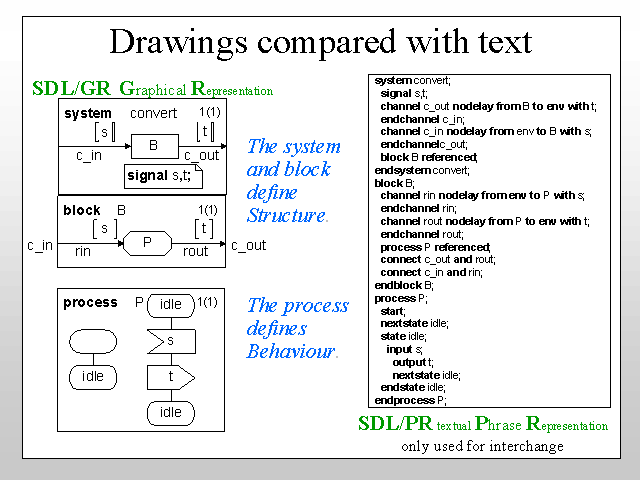Slide 6 of 14
Notes:
Although graphical presentation is one of the key features of SDL, there are two forms of representation:
Graphical SDL/GR Representation and SDL/PR - Phrase Representation
The example above gives the same description in SDL/GR and SDL/PR. Experience shows that as good graphical tools are available, most users prefer to use SDL/GR rather than SDL/PR; mainly because it is easier to read and understand. Most readers and writers are unlikely to encounter SDL/PR, although SDL/PR is used inside tools and for interchange between tools1, sites or organisations. This course therefore only covers SDL/GR, though the complete language includes both forms.
Not everything in SDL/GR is graphical. Some items, such as names, cannot be expressed graphically so that part of SDL/GR is textual and is in common with SDL/PR. The common textual part of the language covers items such as names, data definitions, expressions and assignments.
Diagrams describe the structural composition of entities (or entity types), or behaviour of an entity as a state machine and control flow between states. In the example the system and block diagrams are structural and the process diagram is a behaviour diagram.
The example above gives the same description in SDL/GR and SDL/PR. What may be surprising is that the GR form is no larger than the PR form. The system converts s signals to t signals.
SDL-2000 says nothing about colour, or thickness of lines, or fonts (name, size, style) used for letters. Nor does the language define how diagrams are collected together to form a system. Each diagram has a frame, so it is easy to embed a set of diagrams as a set of figures in a document.
MSC-2000 also has graphical and textual forms, with the textual form used in tools and the graphical form used by the vast majority of users. This course does not cover the textual form.
1 In 1996, the ITU-T Z.106 (CIF) standard was agreed . This is an enhanced SDL/PR that has added information in comments about the graphical representations. CIF allows SDL diagrams from one tool to be read in and displayed in another tool with minimal loss of graphical layout information. The intention is that the diagram is recognisably the same when presented by any tool. There is currently no equivalent for MSC.

